The Apple iPhone 6s and iPhone 6s Plus Review
by Ryan Smith & Joshua Ho on November 2, 2015 8:00 AM EST- Posted in
- Smartphones
- Apple
- Mobile
- SoCs
- iPhone 6s
- iPhone 6s Plus
System Performance Cont'd
Moving on towards our more GPU-bound workloads, we use our standard test suite of benchmarks like GFXBench and 3DMark to get a good idea for performance. Unfortunately, due to the move to iOS 9 the Unity engine version used in Basemark X is no longer working so for now we’re left with 3DMark and GFXBench. There is also Basemark OS II’s graphics test, but this is embedded in a larger benchmark with CPU and storage performance tests.

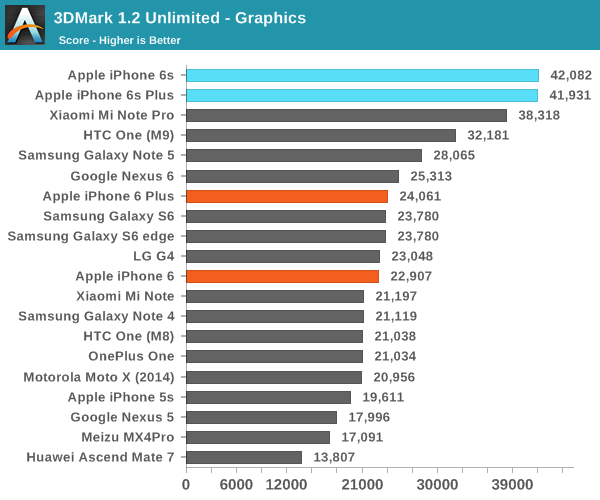
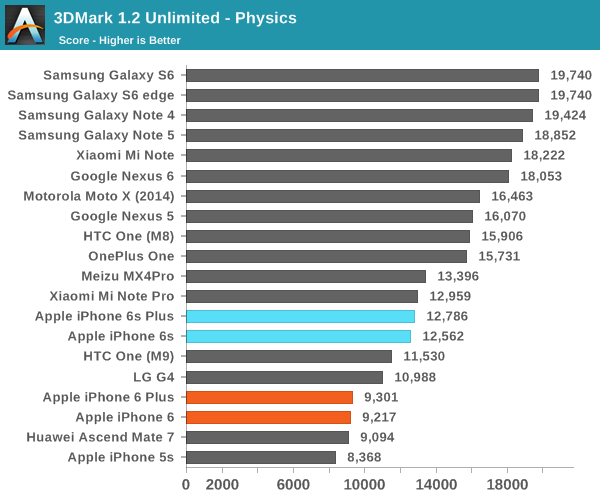
As always with 3DMark, there are some issues in the data structures used. Due to the data dependencies present within the physics test, it is necessary for the CPU to stall for data to be committed to memory before continuing on to the next portion of the test instead of executing instructions in parallel. This strongly reduces the practical performance of the CPU because the architecture is primarily focused upon instruction-level parallelism to deliver major performance gains. However, due to the strong showing in graphics performance the iPhone 6s’ still manage to take the lead.
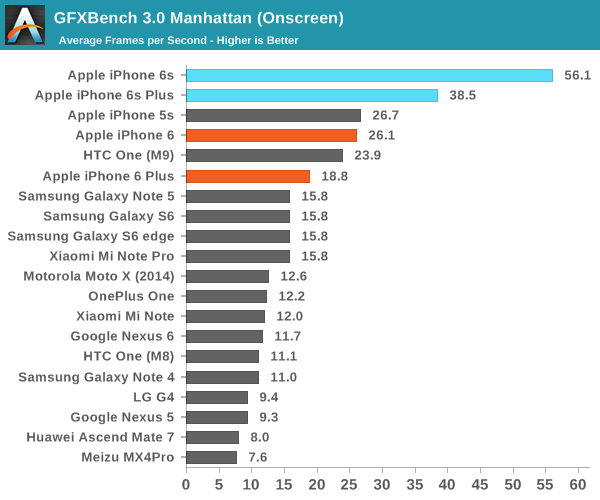
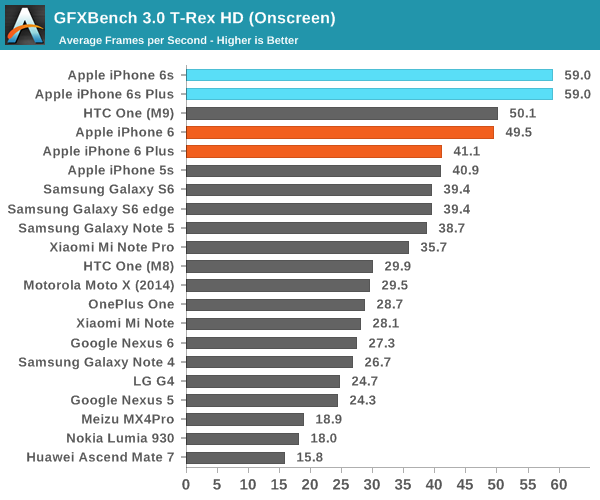
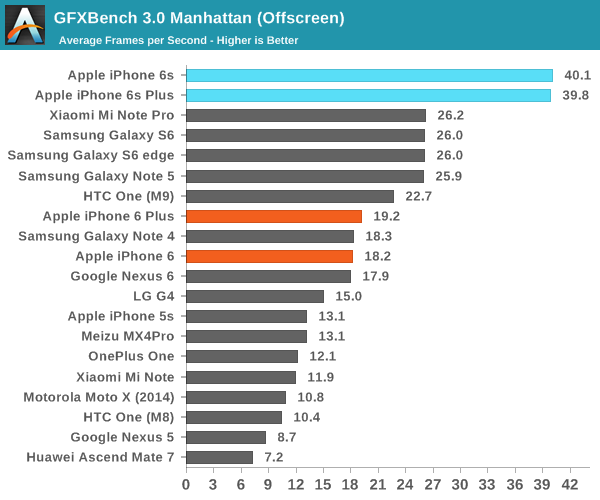

In GFXBench, the A9 SoC just shows absurd performance. It’s strange to think about how the iPad Air 2’s GPU seemed incredibly quick at the time but with the A9 Apple has surpassed that level of performance in their smartphone SoCs. The move to a new generation of PowerVR GPU IP, in addition to the move to a FinFET process node are really the drivers for this kind of performance improvement.
Overall, the Apple A9 SoC is the best SoC in any phone shipping today. In cases like web browsing, gaming, and even just going through the UI it’s quite evident that this new SoC is a major factor in improving performance and smoothness across the board. Something as simple as visiting some popular tech websites will show this, which really goes to show how much “specs” still matter due to their influence on user experience.
NAND Performance
At this point is almost goes without saying that storage performance is important, but in a lot of ways the testing here is still in its early days. In the case of the iPhone 6s we’ve discussed what distinguishes its storage solution from others in this industry, but for those that are unaware the iPhone 6s uses PCIe and NVMe instead of a UFS or eMMC storage solution. In a lot of ways, this makes the storage on board closer to the SSD that you might find in a more expensive PC but due to PCB limitations you won’t necessarily see the enormous parallelism that you might expect from a true SSD. In the time since the initial results we've found that all of our review units use Hynix-supplied NAND. In order to test how this storage solution performs, we use Eric Patno’s storage test which allows for a simple storage test comparable to AndroBench 3.6.
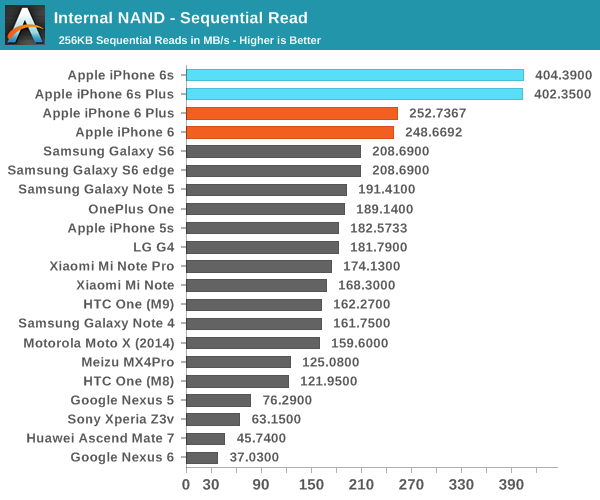
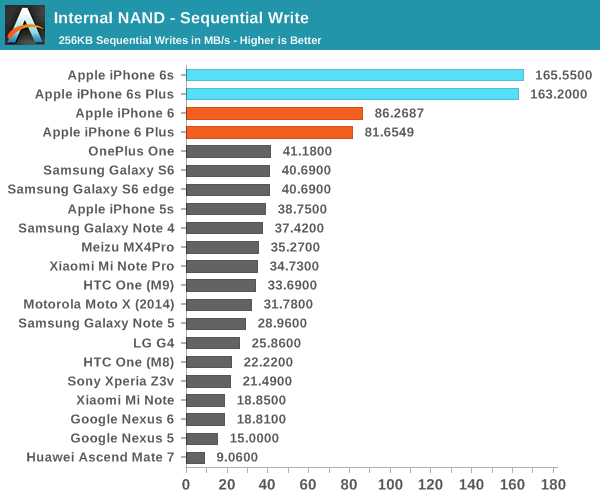
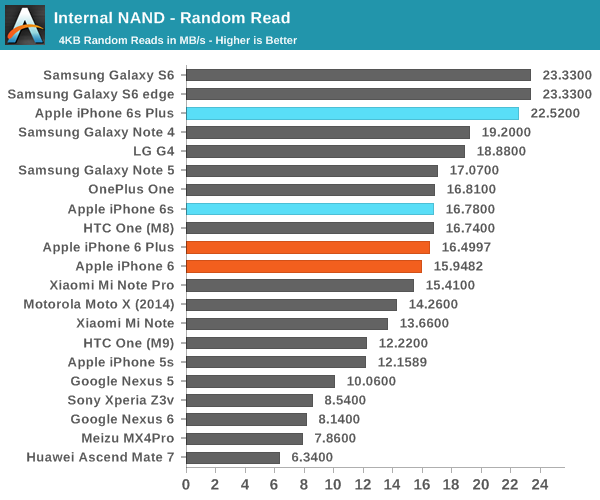
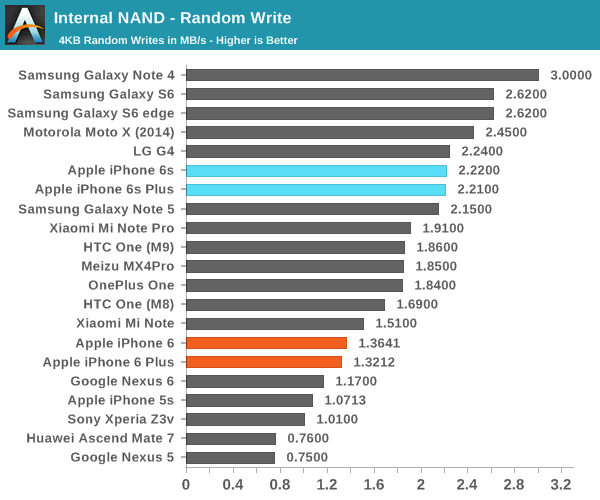
Here, we can really see the enormous performance improvements that result from a combination of TLC NAND with an SLC cache, along with the new NVMe protocol which allows for low CPU overhead and removes architectural bottlenecks to storage performance. This should allow for things like faster burst photos and faster app updates. Downloading and updating apps on the iPhone 6s feels noticeably faster than it is on the iPhone 6, to the extent that small apps feel like they install almost instantly when I’m on a WiFi connection fast enough to saturate storage bandwidth.










531 Comments
View All Comments
osxandwindows - Tuesday, November 3, 2015 - link
Ios problem other iPhones have it not mine tho.kmmatney - Tuesday, November 3, 2015 - link
I haven't done real tests, but overall I'd say my 6S plus has better audio that any other smartphone we've owned. So I've compared it against other iPhone and Android models, but I've never compared to the HTC M1. Nothing to complain about, for sure, onboard sound is clean and relatively loud when needed.mashuri - Wednesday, November 4, 2015 - link
Has their audio hardware changed in any notable way?mashuri - Wednesday, November 4, 2015 - link
BTW, no hissing or buzzing on my 6s+. Very clean sound on my headphones and earbuds.elpadrino27 - Tuesday, November 3, 2015 - link
I'm happy I bought the iPhone 6S Plus. Feels great after switching from the 5S. Just to let you guys know, in India, the iPhone 6S plus models are shipping with 10W power bricks in the box :)zeeBomb - Tuesday, November 3, 2015 - link
I heard of that...I guess India has more smartphone enthusiasts than here! But really, I hope apple can fix that in 2016.davidbressler - Tuesday, November 3, 2015 - link
Minor "correction" (I think).In the first table comparing the change from the 6 (both versions) to 6s (both versions) I think you left out the new front camera flash (the selfie flash). It's significant in that Apple created a new chip to drive turning the display into a flash.
David
metayoshi - Tuesday, November 3, 2015 - link
I'm surprised and very excited to hear that the iPhone 6s is using NVMe as their storage interface protocol. We're living in an exciting future.Turbofrog - Tuesday, November 3, 2015 - link
I fundamentally disagree with the technical assessment you guys have with respect to the camera. It's indefensible that Apple chose to use such a small sensor for their new camera given that the standard for flagship quality has moved forward since the iPhone 6 last year.I understand your argument for Z-height, but one could simply use the same physical focal length and accept the wider field of view. This is possible because the iPhone sensor possesses no actual technical advantages over it's competitors, it merely benefits from Apple's image processing expertise.
In essence, there is an iPhone sensor available to crop down to inside every single Galaxy S6, LG G4, or Lumia 950. With 12MP in 17.3mm^2, that's essentially the same pixel density that its 16MP or 20MP larger sensor competitors have. So if you don't like the wider field of view? Simply crop your image, and you will have the same pixel-level quality (absent processing) as you're getting from the iPhone for free.
And I would argue that given how much processing goes on behind the scenes to correct every single facet of a smartphones imaging chain, the geometric distortion associated with a wider lens, larger image circle, or faster aperture is really a moot point. There's probably a reason that you don't have access to the RAW files coming from an iPhone, and it's not because they look amazing. There are already dozens of lossy operations going on to correct distortion, remove chromatic aberration and colour casts, and lighten vignetting. It's not as if the iPhone's slower lens visibly demonstrates dramatically sharper corners or more detail than its competition, so again I don't understand why you are defending this decision.
TL;DR - the iPhone sensor and lens are technically behind the competition, a decision which only reduces image quality, and can only be realistically defended on the basis of cost-reduction measures.
JoshHo - Friday, November 6, 2015 - link
A wider field of view causes different optical compromises to be taken. In order to maintain acceptable MTF at the edges detail at the center of the photo is often compromised in response. Given the enormous issues I've seen with the Xperia Z3v with distortion, field curvature, and other aberrations I would need evidence to really believe this.